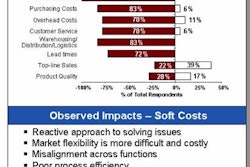New York — October 8, 2008 — Consumer goods manufacturers and retailers continue to adopt radio frequency identification (RFID) largely for the sake of compliance with mandates from the likes of Wal-Mart, Sam's Club and METRO in Germany. However, other benefits that RFID can deliver are growing in importance and will eventually overtake compliance as the leading market driver for RFID uptake in this vertical, according to a survey recently conducted by ABI Research.
While compliance remains the primary motivator for RFID uptake in the consumer goods sector (in contrast to the overall RFID market), according to ABI Research Director Michael Liard, respondents to this survey cited three other considerations that increasingly influence their decisions to trial and deploy the technology: ease of scalability, business process improvement and removal of human intervention.
The breadth of possible retail RFID applications is growing, too. For example, consumer goods manufacturers and retailers also agree that RFID technology can contribute to more effective promotions by helping to determine when promotional products arrive, and if and when they were placed on the store floor. Another area of increasing interest is item-level tagging of apparel, books and other products.
"Declining passive UHF tag and readers price points have positively influenced market adoption, but further reductions are necessary if RFID is to explode in supply chains," Liard said. "Favorable prices will become even more critical as consumer goods manufacturers focus on ROI and total cost of ownership, and when RFID 'goes wider and larger' within enterprises."
The results are discussed in a new white paper from ABI, "Consumer Goods Manufacturers Continue to Press Forward with RFID Adoption Plans," which is available for free download (registration required) at the company's Web site at http://www.abiresearch.com/whitepaperDL.jsp?id=33.
This paper contains findings from 37 consumer retail sector respondents and provides analysis of the survey's results in the areas of RFID system usage and evaluation plans; RFID spending; primary adoption drivers; current and future supply chain management applications by tagging echelon (pallet, case, item); vendor selection criteria, and RFID system requirements.
While compliance remains the primary motivator for RFID uptake in the consumer goods sector (in contrast to the overall RFID market), according to ABI Research Director Michael Liard, respondents to this survey cited three other considerations that increasingly influence their decisions to trial and deploy the technology: ease of scalability, business process improvement and removal of human intervention.
The breadth of possible retail RFID applications is growing, too. For example, consumer goods manufacturers and retailers also agree that RFID technology can contribute to more effective promotions by helping to determine when promotional products arrive, and if and when they were placed on the store floor. Another area of increasing interest is item-level tagging of apparel, books and other products.
"Declining passive UHF tag and readers price points have positively influenced market adoption, but further reductions are necessary if RFID is to explode in supply chains," Liard said. "Favorable prices will become even more critical as consumer goods manufacturers focus on ROI and total cost of ownership, and when RFID 'goes wider and larger' within enterprises."
The results are discussed in a new white paper from ABI, "Consumer Goods Manufacturers Continue to Press Forward with RFID Adoption Plans," which is available for free download (registration required) at the company's Web site at http://www.abiresearch.com/whitepaperDL.jsp?id=33.
This paper contains findings from 37 consumer retail sector respondents and provides analysis of the survey's results in the areas of RFID system usage and evaluation plans; RFID spending; primary adoption drivers; current and future supply chain management applications by tagging echelon (pallet, case, item); vendor selection criteria, and RFID system requirements.









